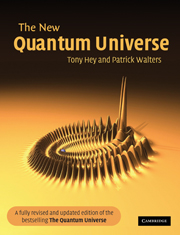Book contents
- Frontmatter
- Contents
- Preface
- Prologue
- Route map
- 1 Waves versus particles
- 2 Heisenberg and uncertainty
- 3 Schrödinger and matter waves
- 4 Atoms and nuclei
- 5 Quantum tunnelling
- 6 Pauli and the elements
- 7 Quantum co-operation and superfluids
- 8 Quantum jumps
- 9 Quantum engineering
- 10 Death of a star
- 11 Feynman rules
- 12 Weak photons and strong glue
- 13 Afterword – quantum physics and science fiction
- Epilogue
- Appendix 1 The size of things
- Appendix 2 Solving the Schrödinger equation
- Glossary
- Quotations and sources
- Suggestions for further reading
- Photo-credits
- Name index
- Subject index
12 - Weak photons and strong glue
Published online by Cambridge University Press: 05 October 2013
- Frontmatter
- Contents
- Preface
- Prologue
- Route map
- 1 Waves versus particles
- 2 Heisenberg and uncertainty
- 3 Schrödinger and matter waves
- 4 Atoms and nuclei
- 5 Quantum tunnelling
- 6 Pauli and the elements
- 7 Quantum co-operation and superfluids
- 8 Quantum jumps
- 9 Quantum engineering
- 10 Death of a star
- 11 Feynman rules
- 12 Weak photons and strong glue
- 13 Afterword – quantum physics and science fiction
- Epilogue
- Appendix 1 The size of things
- Appendix 2 Solving the Schrödinger equation
- Glossary
- Quotations and sources
- Suggestions for further reading
- Photo-credits
- Name index
- Subject index
Summary
Now we are in a position in physics that is different from any other time in history (it's always different!). We have a theory, … so why can't we test the theory right away to see if it's right or wrong? Because what we have to do is calculate the consequences of the theory to test it. This time, the difficulty is this first step.
Richard FeynmanThe double-slit experiment revisited
In this chapter we turn to recent advances in our understanding of the fundamental forces of Nature. As we have said in earlier chapters, the combination of classical electromagnetism, quantum mechanics and relativity provides an astonishingly successful description of electromagnetic forces. The resulting theory is called Quantum ElectroDynamics, or QED for short. For over 50 years physicists searched for similarly successful theories to describe not only the weak forces responsible for natural radioactivity but also the strong forces that hold the nucleus together. It was not until the mid 1970s that real progress was made and these remarkable developments are the subject of this chapter.
Particle physicists now have a unified theory that combines both the electromagnetic and weak forces. The major predictions of this theory have been spectacularly verified by experiments at the CERN high-energy particle physics laboratory in Geneva. We shall describe the theory and these experiments in more detail in this chapter. But particle physicists also believe that they have at last discovered the correct theory of the strong nuclear force.
- Type
- Chapter
- Information
- The New Quantum Universe , pp. 245 - 284Publisher: Cambridge University PressPrint publication year: 2003



